Case Study: BSB51415 Diploma Project Management - Time Management
VerifiedAdded on 2023/06/11
|13
|3823
|340
Case Study
AI Summary
This assignment presents a comprehensive case study focused on project time management within the context of the BSB51415 Diploma of Project Management, specifically addressing the BSBPMG512 unit of competency. The assessment includes written responses, activity tasks such as resource estimation and network analysis, and a portfolio of evidence requiring the development of a project schedule and critical path analysis. The case study revolves around a kitchen renovation project, challenging the student to apply time management principles, identify critical tasks, manage resources, and analyze potential schedule impacts. The student is expected to demonstrate competence in developing work breakdown structures, estimating task durations, utilizing project scheduling tools, implementing progress measurement mechanisms, and recommending improvements to time management activities. The assignment assesses the student's ability to manage project time effectively, track progress, analyze variances, and respond to potential schedule changes to maintain project objectives.
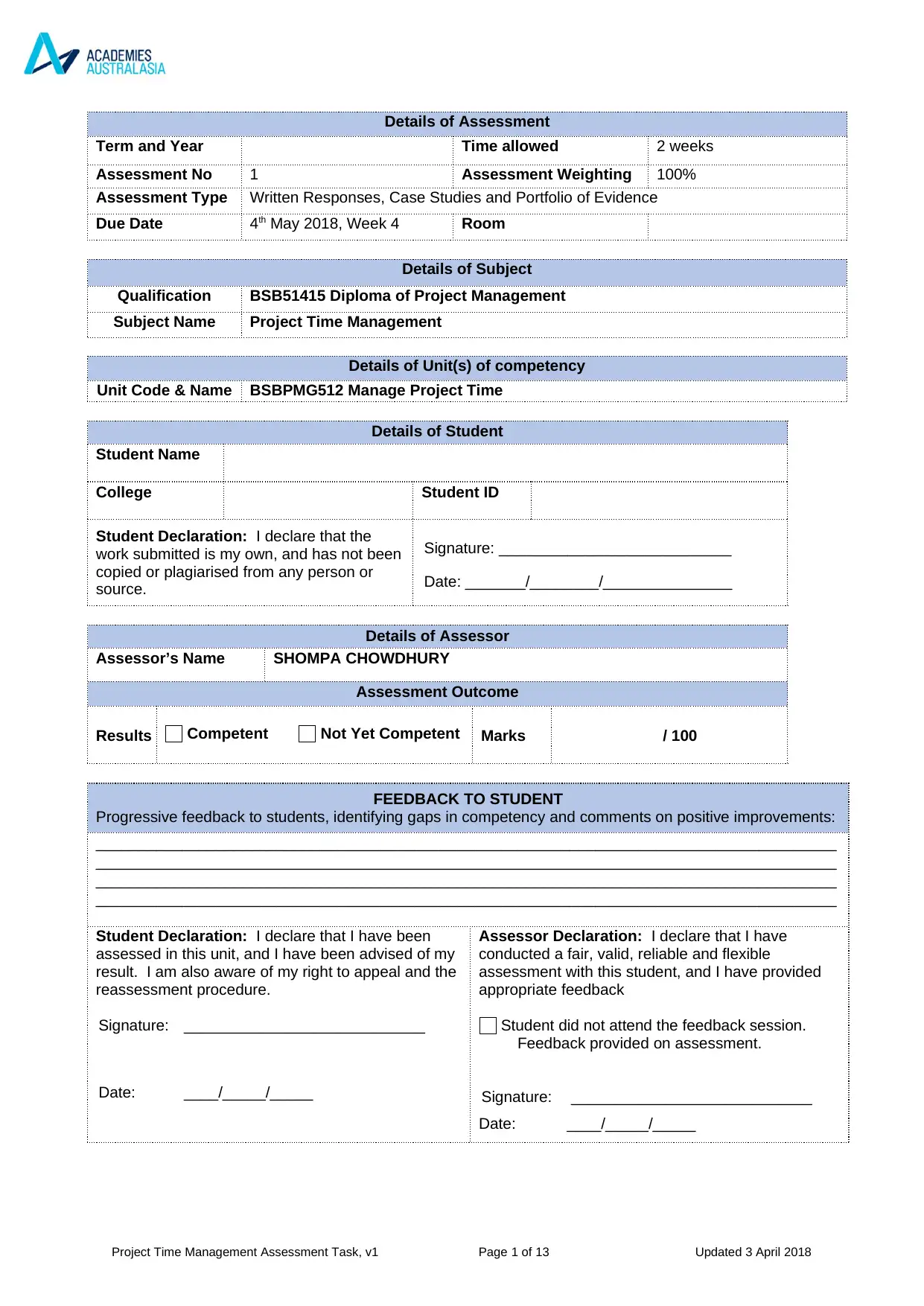
Details of Assessment
Term and Year Time allowed 2 weeks
Assessment No 1 Assessment Weighting 100%
Assessment Type Written Responses, Case Studies and Portfolio of Evidence
Due Date 4th May 2018, Week 4 Room
Details of Subject
Qualification BSB51415 Diploma of Project Management
Subject Name Project Time Management
Details of Unit(s) of competency
Unit Code & Name BSBPMG512 Manage Project Time
Details of Student
Student Name
College Student ID
Student Declaration: I declare that the
work submitted is my own, and has not been
copied or plagiarised from any person or
source.
Signature: ___________________________
Date: _______/________/_______________
Details of Assessor
Assessor’s Name SHOMPA CHOWDHURY
Assessment Outcome
Results Competent Not Yet Competent Marks / 100
FEEDBACK TO STUDENT
Progressive feedback to students, identifying gaps in competency and comments on positive improvements:
______________________________________________________________________________________
______________________________________________________________________________________
______________________________________________________________________________________
______________________________________________________________________________________
Student Declaration: I declare that I have been
assessed in this unit, and I have been advised of my
result. I am also aware of my right to appeal and the
reassessment procedure.
Signature: ____________________________
Date: ____/_____/_____
Assessor Declaration: I declare that I have
conducted a fair, valid, reliable and flexible
assessment with this student, and I have provided
appropriate feedback
Student did not attend the feedback session.
Feedback provided on assessment.
Signature: ____________________________
Date: ____/_____/_____
Project Time Management Assessment Task, v1 Page 1 of 13 Updated 3 April 2018
Term and Year Time allowed 2 weeks
Assessment No 1 Assessment Weighting 100%
Assessment Type Written Responses, Case Studies and Portfolio of Evidence
Due Date 4th May 2018, Week 4 Room
Details of Subject
Qualification BSB51415 Diploma of Project Management
Subject Name Project Time Management
Details of Unit(s) of competency
Unit Code & Name BSBPMG512 Manage Project Time
Details of Student
Student Name
College Student ID
Student Declaration: I declare that the
work submitted is my own, and has not been
copied or plagiarised from any person or
source.
Signature: ___________________________
Date: _______/________/_______________
Details of Assessor
Assessor’s Name SHOMPA CHOWDHURY
Assessment Outcome
Results Competent Not Yet Competent Marks / 100
FEEDBACK TO STUDENT
Progressive feedback to students, identifying gaps in competency and comments on positive improvements:
______________________________________________________________________________________
______________________________________________________________________________________
______________________________________________________________________________________
______________________________________________________________________________________
Student Declaration: I declare that I have been
assessed in this unit, and I have been advised of my
result. I am also aware of my right to appeal and the
reassessment procedure.
Signature: ____________________________
Date: ____/_____/_____
Assessor Declaration: I declare that I have
conducted a fair, valid, reliable and flexible
assessment with this student, and I have provided
appropriate feedback
Student did not attend the feedback session.
Feedback provided on assessment.
Signature: ____________________________
Date: ____/_____/_____
Project Time Management Assessment Task, v1 Page 1 of 13 Updated 3 April 2018
Paraphrase This Document
Need a fresh take? Get an instant paraphrase of this document with our AI Paraphraser

Purpose of the Assessment
The purpose of this assessment is to assess the
student in the following learning outcomes:
Competent
(C)
Not yet Competent
(NYC)
1.1 Develop the work breakdown structure with
sufficient detail to enable effective planning and
control
1.2 Estimate the duration and effort, sequence and
dependencies of tasks to achieve project
deliverables
1.3 Use project-scheduling tools and techniques to
identify schedule impact on project time
management, resource requirements, costs and
risks
1.4 Contribute to achieving an agreed schedule
baseline and communication of the schedule to
stakeholders
2.1 Implement mechanisms to measure, record and
report progress of activities in relation to the agreed
schedule
2.2 Conduct ongoing analysis to identify baseline
variance
2.3 Analyse and forecast the impact of changes to
the schedule
2.4 Review progress throughout the project life cycle
and implement agreed schedule changes
2.5 Develop responses to potential or actual
schedule changes and implement them to maintain
project objectives
3.1 Review schedule performance records to
determine the effectiveness of time-management
activities
3.2Identify and document time-management issues
and recommend improvements
Assessment/evidence gathering conditions
Each assessment component is recorded as either Competent (C) or Not Yet Competent (NYC). A student
can only achieve competence when all assessment components listed under “Purpose of the assessment”
section are recorded as competent. Your trainer will give you feedback after the completion of each
assessment. A student who is assessed as NYC (Not Yet Competent) is eligible for re-assessment.
Resources required for this Assessment
Project Time Management Assessment Task, v1 Page 2 of 13 Updated 3 April 2018
The purpose of this assessment is to assess the
student in the following learning outcomes:
Competent
(C)
Not yet Competent
(NYC)
1.1 Develop the work breakdown structure with
sufficient detail to enable effective planning and
control
1.2 Estimate the duration and effort, sequence and
dependencies of tasks to achieve project
deliverables
1.3 Use project-scheduling tools and techniques to
identify schedule impact on project time
management, resource requirements, costs and
risks
1.4 Contribute to achieving an agreed schedule
baseline and communication of the schedule to
stakeholders
2.1 Implement mechanisms to measure, record and
report progress of activities in relation to the agreed
schedule
2.2 Conduct ongoing analysis to identify baseline
variance
2.3 Analyse and forecast the impact of changes to
the schedule
2.4 Review progress throughout the project life cycle
and implement agreed schedule changes
2.5 Develop responses to potential or actual
schedule changes and implement them to maintain
project objectives
3.1 Review schedule performance records to
determine the effectiveness of time-management
activities
3.2Identify and document time-management issues
and recommend improvements
Assessment/evidence gathering conditions
Each assessment component is recorded as either Competent (C) or Not Yet Competent (NYC). A student
can only achieve competence when all assessment components listed under “Purpose of the assessment”
section are recorded as competent. Your trainer will give you feedback after the completion of each
assessment. A student who is assessed as NYC (Not Yet Competent) is eligible for re-assessment.
Resources required for this Assessment
Project Time Management Assessment Task, v1 Page 2 of 13 Updated 3 April 2018
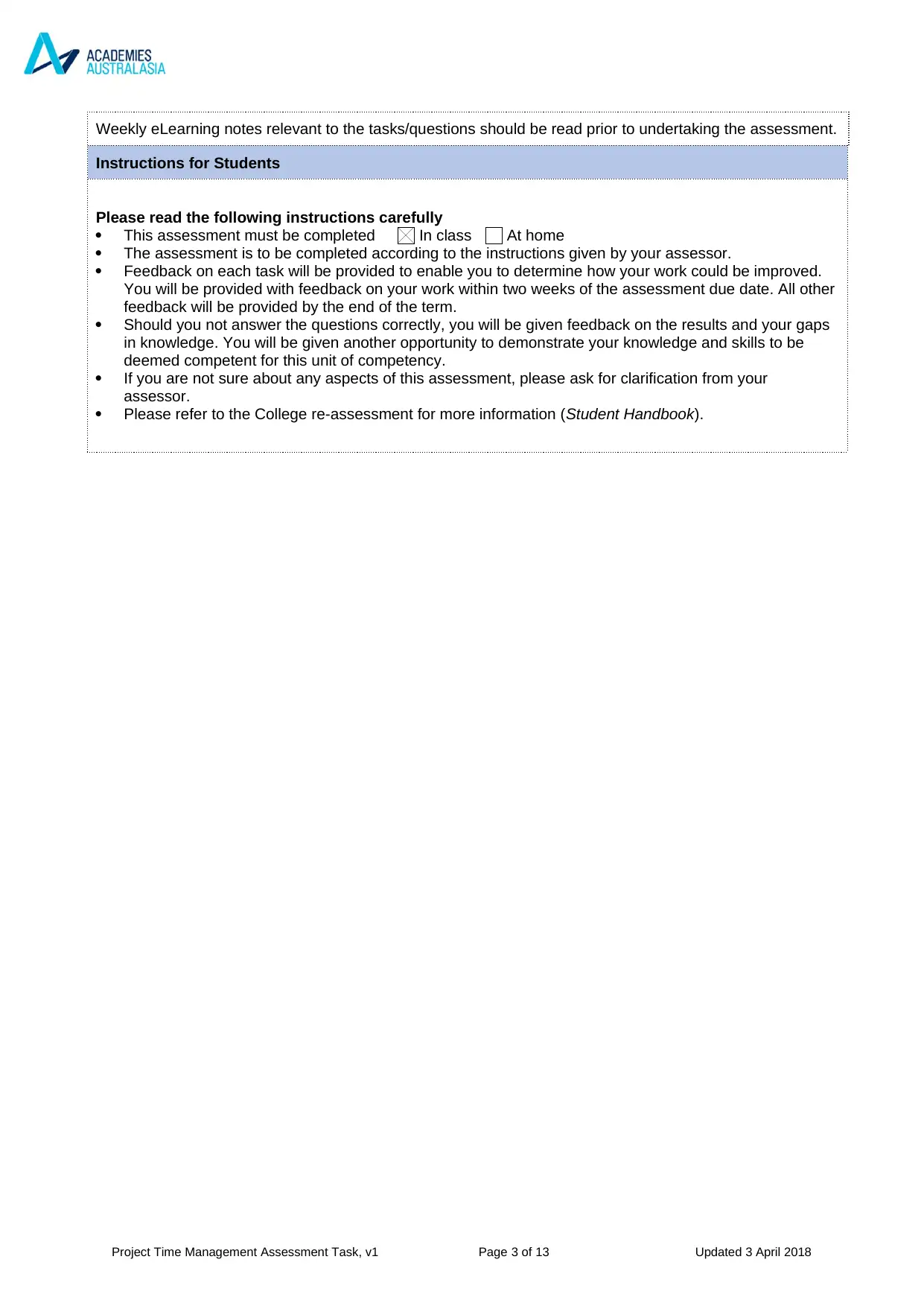
Weekly eLearning notes relevant to the tasks/questions should be read prior to undertaking the assessment.
Instructions for Students
Please read the following instructions carefully
This assessment must be completed In class At home
The assessment is to be completed according to the instructions given by your assessor.
Feedback on each task will be provided to enable you to determine how your work could be improved.
You will be provided with feedback on your work within two weeks of the assessment due date. All other
feedback will be provided by the end of the term.
Should you not answer the questions correctly, you will be given feedback on the results and your gaps
in knowledge. You will be given another opportunity to demonstrate your knowledge and skills to be
deemed competent for this unit of competency.
If you are not sure about any aspects of this assessment, please ask for clarification from your
assessor.
Please refer to the College re-assessment for more information (Student Handbook).
Project Time Management Assessment Task, v1 Page 3 of 13 Updated 3 April 2018
Instructions for Students
Please read the following instructions carefully
This assessment must be completed In class At home
The assessment is to be completed according to the instructions given by your assessor.
Feedback on each task will be provided to enable you to determine how your work could be improved.
You will be provided with feedback on your work within two weeks of the assessment due date. All other
feedback will be provided by the end of the term.
Should you not answer the questions correctly, you will be given feedback on the results and your gaps
in knowledge. You will be given another opportunity to demonstrate your knowledge and skills to be
deemed competent for this unit of competency.
If you are not sure about any aspects of this assessment, please ask for clarification from your
assessor.
Please refer to the College re-assessment for more information (Student Handbook).
Project Time Management Assessment Task, v1 Page 3 of 13 Updated 3 April 2018
⊘ This is a preview!⊘
Do you want full access?
Subscribe today to unlock all pages.

Trusted by 1+ million students worldwide
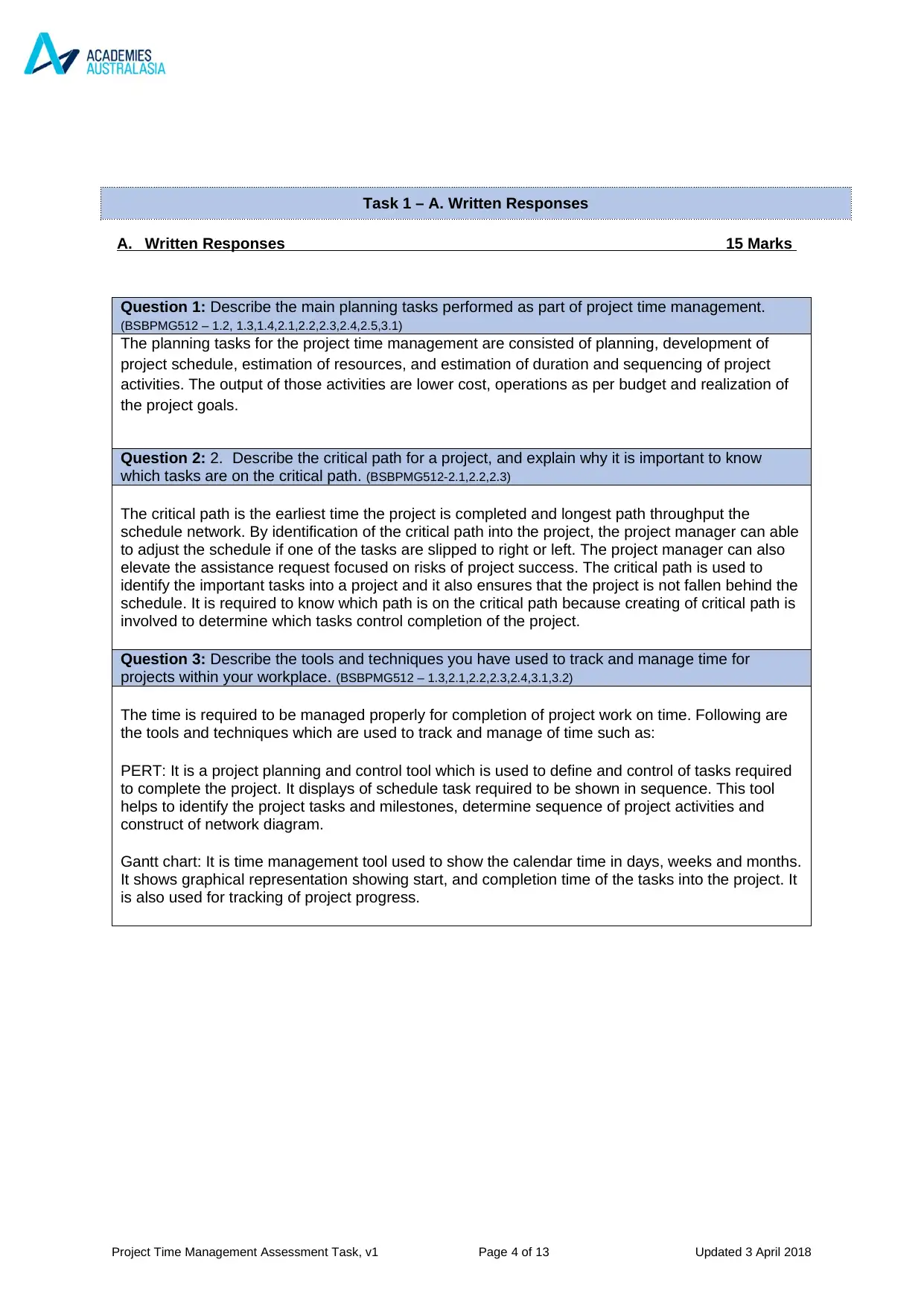
Task 1 – A. Written Responses
A. Written Responses 15 Marks
Question 1: Describe the main planning tasks performed as part of project time management.
(BSBPMG512 – 1.2, 1.3,1.4,2.1,2.2,2.3,2.4,2.5,3.1)
The planning tasks for the project time management are consisted of planning, development of
project schedule, estimation of resources, and estimation of duration and sequencing of project
activities. The output of those activities are lower cost, operations as per budget and realization of
the project goals.
Question 2: 2. Describe the critical path for a project, and explain why it is important to know
which tasks are on the critical path. (BSBPMG512-2.1,2.2,2.3)
The critical path is the earliest time the project is completed and longest path throughput the
schedule network. By identification of the critical path into the project, the project manager can able
to adjust the schedule if one of the tasks are slipped to right or left. The project manager can also
elevate the assistance request focused on risks of project success. The critical path is used to
identify the important tasks into a project and it also ensures that the project is not fallen behind the
schedule. It is required to know which path is on the critical path because creating of critical path is
involved to determine which tasks control completion of the project.
Question 3: Describe the tools and techniques you have used to track and manage time for
projects within your workplace. (BSBPMG512 – 1.3,2.1,2.2,2.3,2.4,3.1,3.2)
The time is required to be managed properly for completion of project work on time. Following are
the tools and techniques which are used to track and manage of time such as:
PERT: It is a project planning and control tool which is used to define and control of tasks required
to complete the project. It displays of schedule task required to be shown in sequence. This tool
helps to identify the project tasks and milestones, determine sequence of project activities and
construct of network diagram.
Gantt chart: It is time management tool used to show the calendar time in days, weeks and months.
It shows graphical representation showing start, and completion time of the tasks into the project. It
is also used for tracking of project progress.
Project Time Management Assessment Task, v1 Page 4 of 13 Updated 3 April 2018
A. Written Responses 15 Marks
Question 1: Describe the main planning tasks performed as part of project time management.
(BSBPMG512 – 1.2, 1.3,1.4,2.1,2.2,2.3,2.4,2.5,3.1)
The planning tasks for the project time management are consisted of planning, development of
project schedule, estimation of resources, and estimation of duration and sequencing of project
activities. The output of those activities are lower cost, operations as per budget and realization of
the project goals.
Question 2: 2. Describe the critical path for a project, and explain why it is important to know
which tasks are on the critical path. (BSBPMG512-2.1,2.2,2.3)
The critical path is the earliest time the project is completed and longest path throughput the
schedule network. By identification of the critical path into the project, the project manager can able
to adjust the schedule if one of the tasks are slipped to right or left. The project manager can also
elevate the assistance request focused on risks of project success. The critical path is used to
identify the important tasks into a project and it also ensures that the project is not fallen behind the
schedule. It is required to know which path is on the critical path because creating of critical path is
involved to determine which tasks control completion of the project.
Question 3: Describe the tools and techniques you have used to track and manage time for
projects within your workplace. (BSBPMG512 – 1.3,2.1,2.2,2.3,2.4,3.1,3.2)
The time is required to be managed properly for completion of project work on time. Following are
the tools and techniques which are used to track and manage of time such as:
PERT: It is a project planning and control tool which is used to define and control of tasks required
to complete the project. It displays of schedule task required to be shown in sequence. This tool
helps to identify the project tasks and milestones, determine sequence of project activities and
construct of network diagram.
Gantt chart: It is time management tool used to show the calendar time in days, weeks and months.
It shows graphical representation showing start, and completion time of the tasks into the project. It
is also used for tracking of project progress.
Project Time Management Assessment Task, v1 Page 4 of 13 Updated 3 April 2018
Paraphrase This Document
Need a fresh take? Get an instant paraphrase of this document with our AI Paraphraser
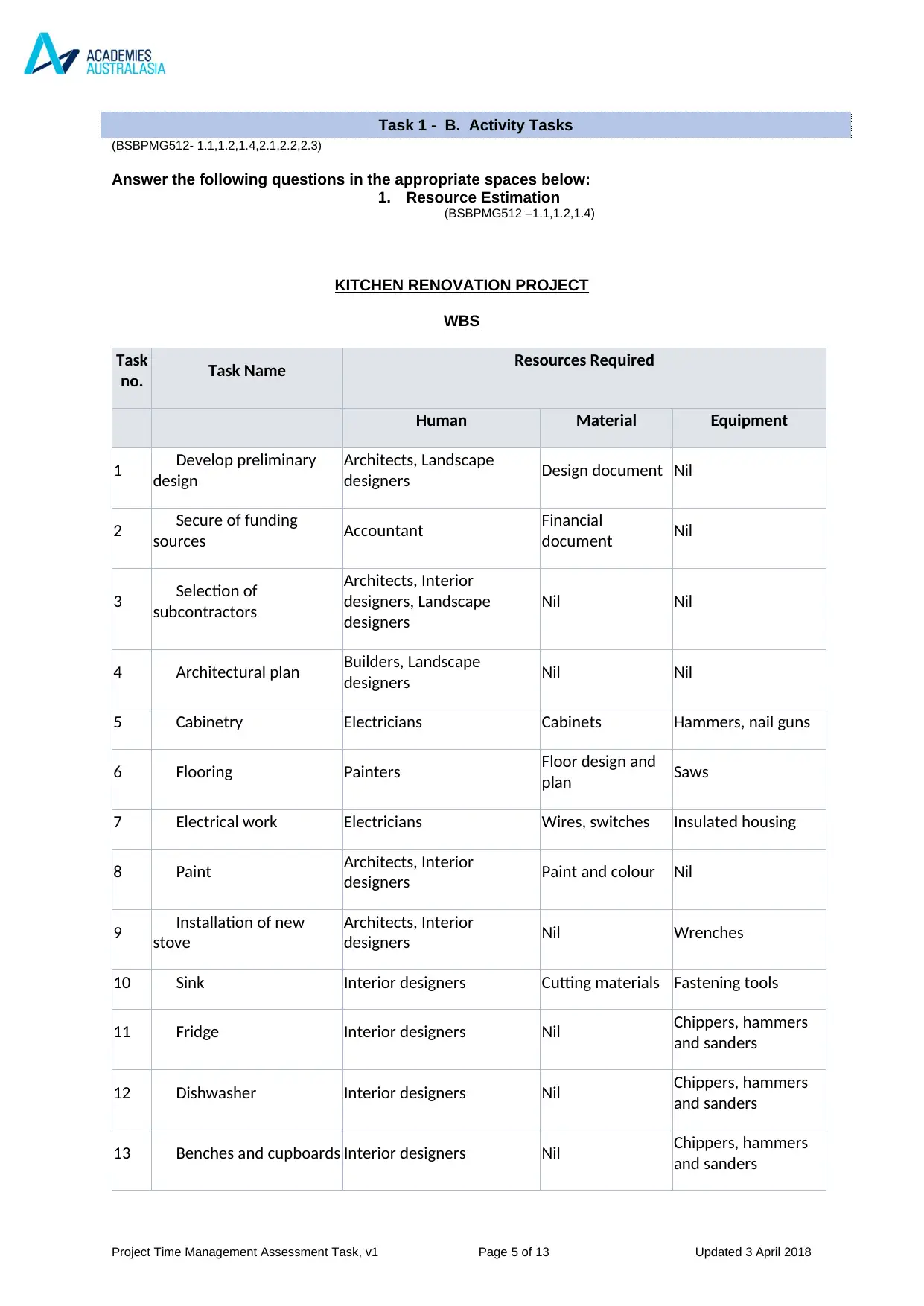
Task 1 - B. Activity Tasks
(BSBPMG512- 1.1,1.2,1.4,2.1,2.2,2.3)
Answer the following questions in the appropriate spaces below:
1. Resource Estimation
(BSBPMG512 –1.1,1.2,1.4)
KITCHEN RENOVATION PROJECT
WBS
Task
no. Task Name Resources Required
Human Material Equipment
1 Develop preliminary
design
Architects, Landscape
designers Design document Nil
2 Secure of funding
sources Accountant Financial
document Nil
3 Selection of
subcontractors
Architects, Interior
designers, Landscape
designers
Nil Nil
4 Architectural plan Builders, Landscape
designers Nil Nil
5 Cabinetry Electricians Cabinets Hammers, nail guns
6 Flooring Painters Floor design and
plan Saws
7 Electrical work Electricians Wires, switches Insulated housing
8 Paint Architects, Interior
designers Paint and colour Nil
9 Installation of new
stove
Architects, Interior
designers Nil Wrenches
10 Sink Interior designers Cutting materials Fastening tools
11 Fridge Interior designers Nil Chippers, hammers
and sanders
12 Dishwasher Interior designers Nil Chippers, hammers
and sanders
13 Benches and cupboards Interior designers Nil Chippers, hammers
and sanders
Project Time Management Assessment Task, v1 Page 5 of 13 Updated 3 April 2018
(BSBPMG512- 1.1,1.2,1.4,2.1,2.2,2.3)
Answer the following questions in the appropriate spaces below:
1. Resource Estimation
(BSBPMG512 –1.1,1.2,1.4)
KITCHEN RENOVATION PROJECT
WBS
Task
no. Task Name Resources Required
Human Material Equipment
1 Develop preliminary
design
Architects, Landscape
designers Design document Nil
2 Secure of funding
sources Accountant Financial
document Nil
3 Selection of
subcontractors
Architects, Interior
designers, Landscape
designers
Nil Nil
4 Architectural plan Builders, Landscape
designers Nil Nil
5 Cabinetry Electricians Cabinets Hammers, nail guns
6 Flooring Painters Floor design and
plan Saws
7 Electrical work Electricians Wires, switches Insulated housing
8 Paint Architects, Interior
designers Paint and colour Nil
9 Installation of new
stove
Architects, Interior
designers Nil Wrenches
10 Sink Interior designers Cutting materials Fastening tools
11 Fridge Interior designers Nil Chippers, hammers
and sanders
12 Dishwasher Interior designers Nil Chippers, hammers
and sanders
13 Benches and cupboards Interior designers Nil Chippers, hammers
and sanders
Project Time Management Assessment Task, v1 Page 5 of 13 Updated 3 April 2018
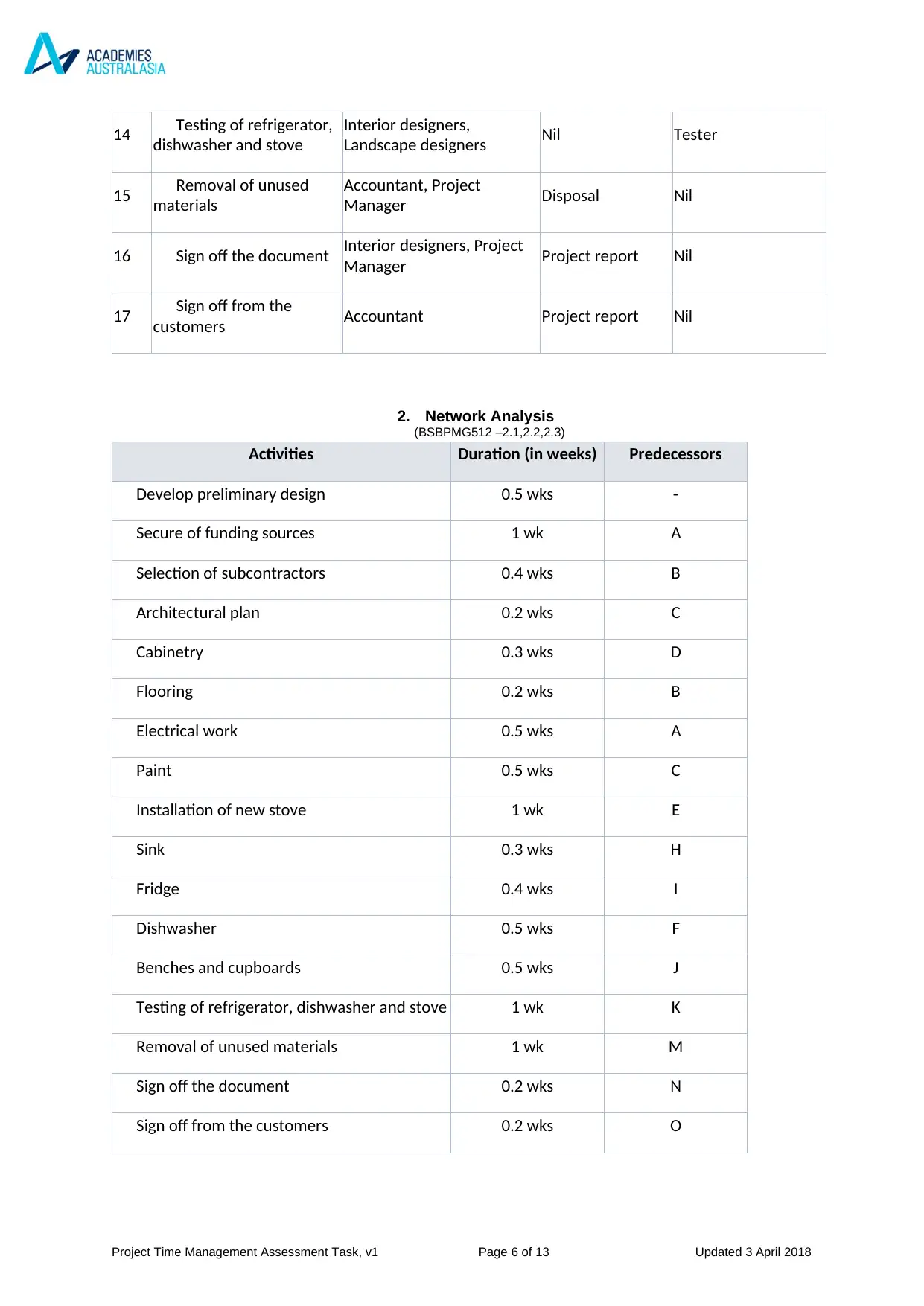
14 Testing of refrigerator,
dishwasher and stove
Interior designers,
Landscape designers Nil Tester
15 Removal of unused
materials
Accountant, Project
Manager Disposal Nil
16 Sign off the document Interior designers, Project
Manager Project report Nil
17 Sign off from the
customers Accountant Project report Nil
2. Network Analysis
(BSBPMG512 –2.1,2.2,2.3)
Activities Duration (in weeks) Predecessors
Develop preliminary design 0.5 wks -
Secure of funding sources 1 wk A
Selection of subcontractors 0.4 wks B
Architectural plan 0.2 wks C
Cabinetry 0.3 wks D
Flooring 0.2 wks B
Electrical work 0.5 wks A
Paint 0.5 wks C
Installation of new stove 1 wk E
Sink 0.3 wks H
Fridge 0.4 wks I
Dishwasher 0.5 wks F
Benches and cupboards 0.5 wks J
Testing of refrigerator, dishwasher and stove 1 wk K
Removal of unused materials 1 wk M
Sign off the document 0.2 wks N
Sign off from the customers 0.2 wks O
Project Time Management Assessment Task, v1 Page 6 of 13 Updated 3 April 2018
dishwasher and stove
Interior designers,
Landscape designers Nil Tester
15 Removal of unused
materials
Accountant, Project
Manager Disposal Nil
16 Sign off the document Interior designers, Project
Manager Project report Nil
17 Sign off from the
customers Accountant Project report Nil
2. Network Analysis
(BSBPMG512 –2.1,2.2,2.3)
Activities Duration (in weeks) Predecessors
Develop preliminary design 0.5 wks -
Secure of funding sources 1 wk A
Selection of subcontractors 0.4 wks B
Architectural plan 0.2 wks C
Cabinetry 0.3 wks D
Flooring 0.2 wks B
Electrical work 0.5 wks A
Paint 0.5 wks C
Installation of new stove 1 wk E
Sink 0.3 wks H
Fridge 0.4 wks I
Dishwasher 0.5 wks F
Benches and cupboards 0.5 wks J
Testing of refrigerator, dishwasher and stove 1 wk K
Removal of unused materials 1 wk M
Sign off the document 0.2 wks N
Sign off from the customers 0.2 wks O
Project Time Management Assessment Task, v1 Page 6 of 13 Updated 3 April 2018
⊘ This is a preview!⊘
Do you want full access?
Subscribe today to unlock all pages.

Trusted by 1+ million students worldwide
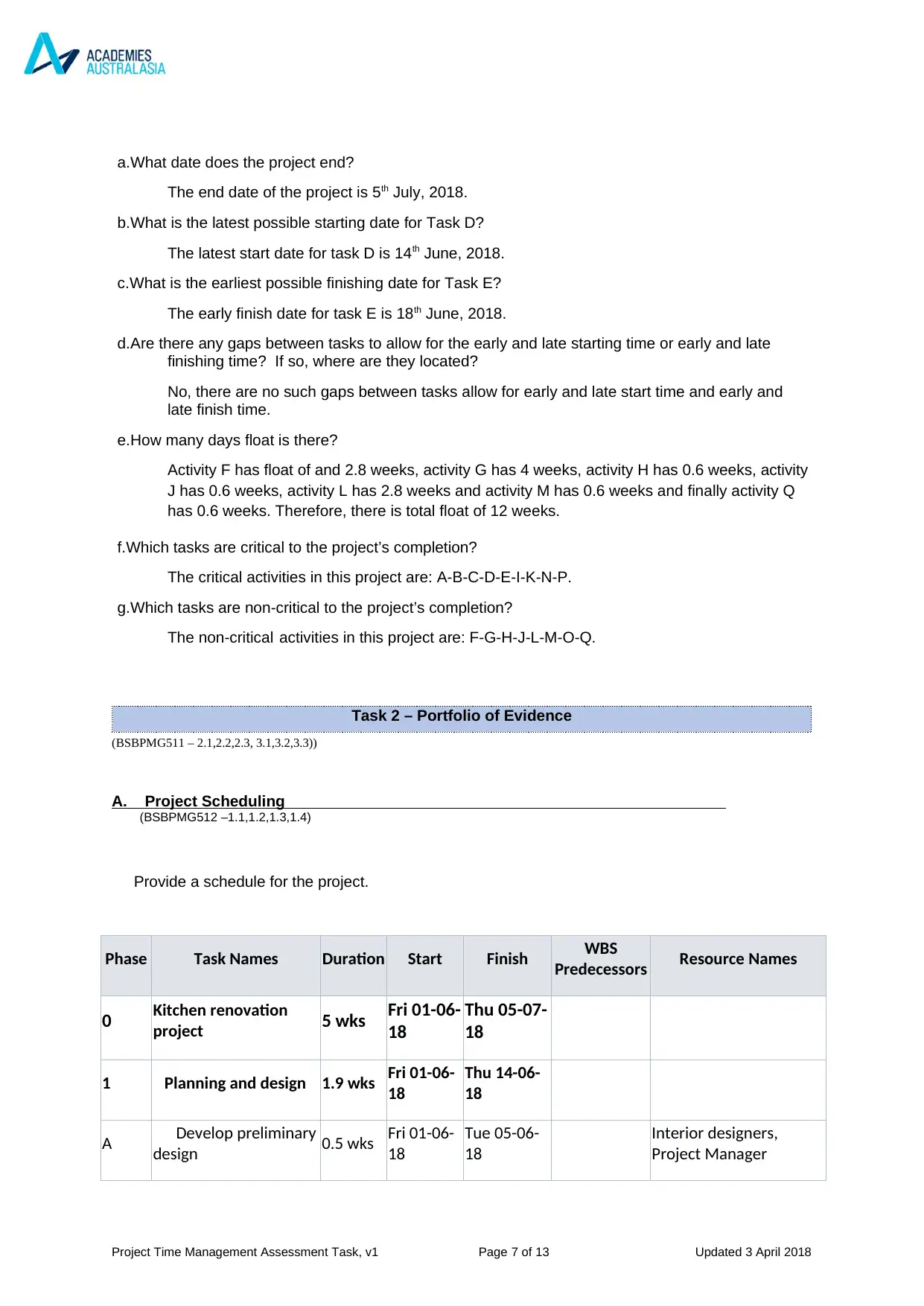
a.What date does the project end?
The end date of the project is 5th July, 2018.
b.What is the latest possible starting date for Task D?
The latest start date for task D is 14th June, 2018.
c.What is the earliest possible finishing date for Task E?
The early finish date for task E is 18th June, 2018.
d.Are there any gaps between tasks to allow for the early and late starting time or early and late
finishing time? If so, where are they located?
No, there are no such gaps between tasks allow for early and late start time and early and
late finish time.
e.How many days float is there?
Activity F has float of and 2.8 weeks, activity G has 4 weeks, activity H has 0.6 weeks, activity
J has 0.6 weeks, activity L has 2.8 weeks and activity M has 0.6 weeks and finally activity Q
has 0.6 weeks. Therefore, there is total float of 12 weeks.
f.Which tasks are critical to the project’s completion?
The critical activities in this project are: A-B-C-D-E-I-K-N-P.
g.Which tasks are non-critical to the project’s completion?
The non-critical activities in this project are: F-G-H-J-L-M-O-Q.
Task 2 – Portfolio of Evidence
(BSBPMG511 – 2.1,2.2,2.3, 3.1,3.2,3.3))
A. Project Scheduling
(BSBPMG512 –1.1,1.2,1.3,1.4)
Provide a schedule for the project.
Phase Task Names Duration Start Finish WBS
Predecessors Resource Names
0 Kitchen renovation
project 5 wks Fri 01-06-
18
Thu 05-07-
18
1 Planning and design 1.9 wks Fri 01-06-
18
Thu 14-06-
18
A Develop preliminary
design 0.5 wks Fri 01-06-
18
Tue 05-06-
18
Interior designers,
Project Manager
Project Time Management Assessment Task, v1 Page 7 of 13 Updated 3 April 2018
The end date of the project is 5th July, 2018.
b.What is the latest possible starting date for Task D?
The latest start date for task D is 14th June, 2018.
c.What is the earliest possible finishing date for Task E?
The early finish date for task E is 18th June, 2018.
d.Are there any gaps between tasks to allow for the early and late starting time or early and late
finishing time? If so, where are they located?
No, there are no such gaps between tasks allow for early and late start time and early and
late finish time.
e.How many days float is there?
Activity F has float of and 2.8 weeks, activity G has 4 weeks, activity H has 0.6 weeks, activity
J has 0.6 weeks, activity L has 2.8 weeks and activity M has 0.6 weeks and finally activity Q
has 0.6 weeks. Therefore, there is total float of 12 weeks.
f.Which tasks are critical to the project’s completion?
The critical activities in this project are: A-B-C-D-E-I-K-N-P.
g.Which tasks are non-critical to the project’s completion?
The non-critical activities in this project are: F-G-H-J-L-M-O-Q.
Task 2 – Portfolio of Evidence
(BSBPMG511 – 2.1,2.2,2.3, 3.1,3.2,3.3))
A. Project Scheduling
(BSBPMG512 –1.1,1.2,1.3,1.4)
Provide a schedule for the project.
Phase Task Names Duration Start Finish WBS
Predecessors Resource Names
0 Kitchen renovation
project 5 wks Fri 01-06-
18
Thu 05-07-
18
1 Planning and design 1.9 wks Fri 01-06-
18
Thu 14-06-
18
A Develop preliminary
design 0.5 wks Fri 01-06-
18
Tue 05-06-
18
Interior designers,
Project Manager
Project Time Management Assessment Task, v1 Page 7 of 13 Updated 3 April 2018
Paraphrase This Document
Need a fresh take? Get an instant paraphrase of this document with our AI Paraphraser
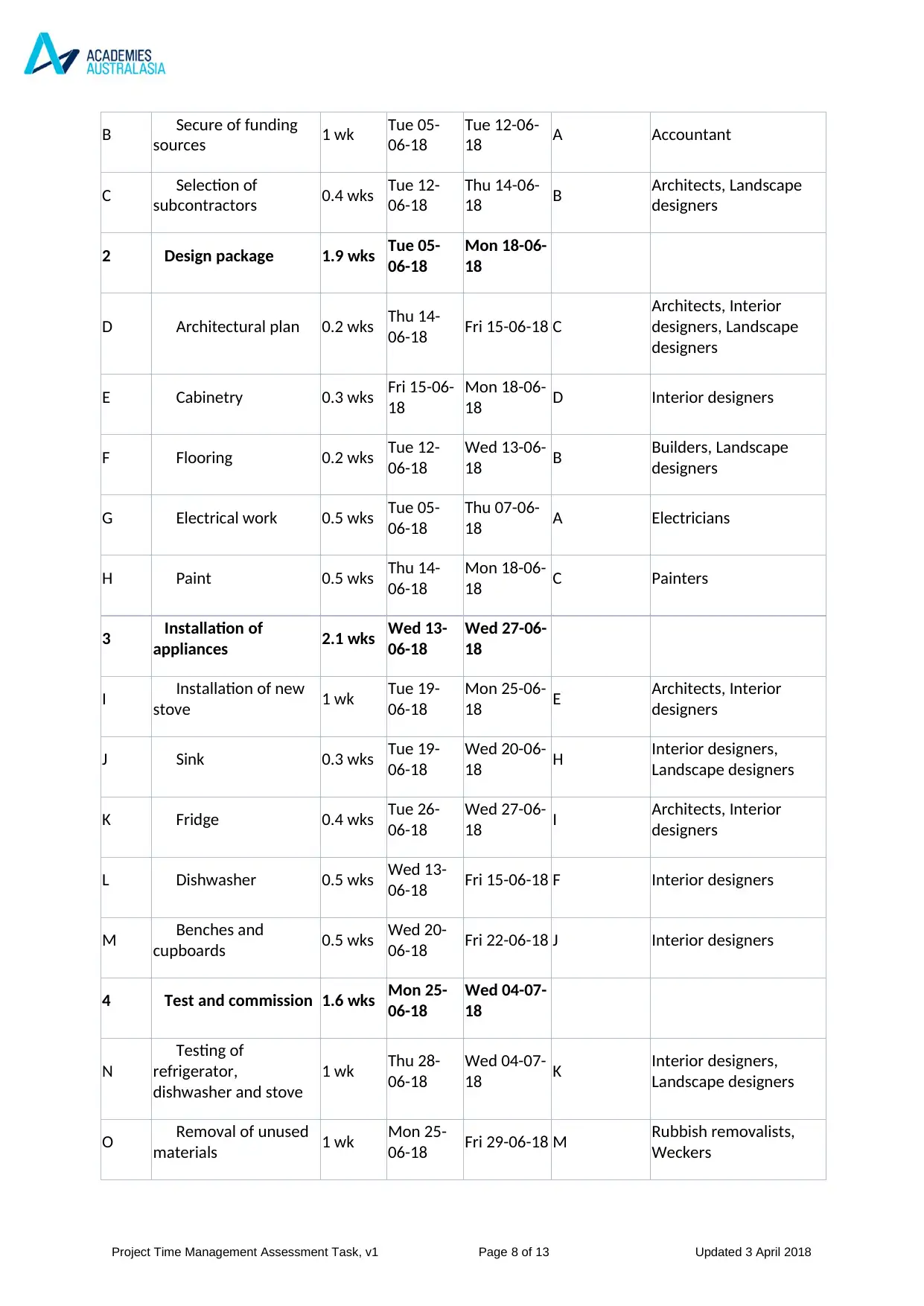
B Secure of funding
sources 1 wk Tue 05-
06-18
Tue 12-06-
18 A Accountant
C Selection of
subcontractors 0.4 wks Tue 12-
06-18
Thu 14-06-
18 B Architects, Landscape
designers
2 Design package 1.9 wks Tue 05-
06-18
Mon 18-06-
18
D Architectural plan 0.2 wks Thu 14-
06-18 Fri 15-06-18 C
Architects, Interior
designers, Landscape
designers
E Cabinetry 0.3 wks Fri 15-06-
18
Mon 18-06-
18 D Interior designers
F Flooring 0.2 wks Tue 12-
06-18
Wed 13-06-
18 B Builders, Landscape
designers
G Electrical work 0.5 wks Tue 05-
06-18
Thu 07-06-
18 A Electricians
H Paint 0.5 wks Thu 14-
06-18
Mon 18-06-
18 C Painters
3 Installation of
appliances 2.1 wks Wed 13-
06-18
Wed 27-06-
18
I Installation of new
stove 1 wk Tue 19-
06-18
Mon 25-06-
18 E Architects, Interior
designers
J Sink 0.3 wks Tue 19-
06-18
Wed 20-06-
18 H Interior designers,
Landscape designers
K Fridge 0.4 wks Tue 26-
06-18
Wed 27-06-
18 I Architects, Interior
designers
L Dishwasher 0.5 wks Wed 13-
06-18 Fri 15-06-18 F Interior designers
M Benches and
cupboards 0.5 wks Wed 20-
06-18 Fri 22-06-18 J Interior designers
4 Test and commission 1.6 wks Mon 25-
06-18
Wed 04-07-
18
N
Testing of
refrigerator,
dishwasher and stove
1 wk Thu 28-
06-18
Wed 04-07-
18 K Interior designers,
Landscape designers
O Removal of unused
materials 1 wk Mon 25-
06-18 Fri 29-06-18 M Rubbish removalists,
Weckers
Project Time Management Assessment Task, v1 Page 8 of 13 Updated 3 April 2018
sources 1 wk Tue 05-
06-18
Tue 12-06-
18 A Accountant
C Selection of
subcontractors 0.4 wks Tue 12-
06-18
Thu 14-06-
18 B Architects, Landscape
designers
2 Design package 1.9 wks Tue 05-
06-18
Mon 18-06-
18
D Architectural plan 0.2 wks Thu 14-
06-18 Fri 15-06-18 C
Architects, Interior
designers, Landscape
designers
E Cabinetry 0.3 wks Fri 15-06-
18
Mon 18-06-
18 D Interior designers
F Flooring 0.2 wks Tue 12-
06-18
Wed 13-06-
18 B Builders, Landscape
designers
G Electrical work 0.5 wks Tue 05-
06-18
Thu 07-06-
18 A Electricians
H Paint 0.5 wks Thu 14-
06-18
Mon 18-06-
18 C Painters
3 Installation of
appliances 2.1 wks Wed 13-
06-18
Wed 27-06-
18
I Installation of new
stove 1 wk Tue 19-
06-18
Mon 25-06-
18 E Architects, Interior
designers
J Sink 0.3 wks Tue 19-
06-18
Wed 20-06-
18 H Interior designers,
Landscape designers
K Fridge 0.4 wks Tue 26-
06-18
Wed 27-06-
18 I Architects, Interior
designers
L Dishwasher 0.5 wks Wed 13-
06-18 Fri 15-06-18 F Interior designers
M Benches and
cupboards 0.5 wks Wed 20-
06-18 Fri 22-06-18 J Interior designers
4 Test and commission 1.6 wks Mon 25-
06-18
Wed 04-07-
18
N
Testing of
refrigerator,
dishwasher and stove
1 wk Thu 28-
06-18
Wed 04-07-
18 K Interior designers,
Landscape designers
O Removal of unused
materials 1 wk Mon 25-
06-18 Fri 29-06-18 M Rubbish removalists,
Weckers
Project Time Management Assessment Task, v1 Page 8 of 13 Updated 3 April 2018
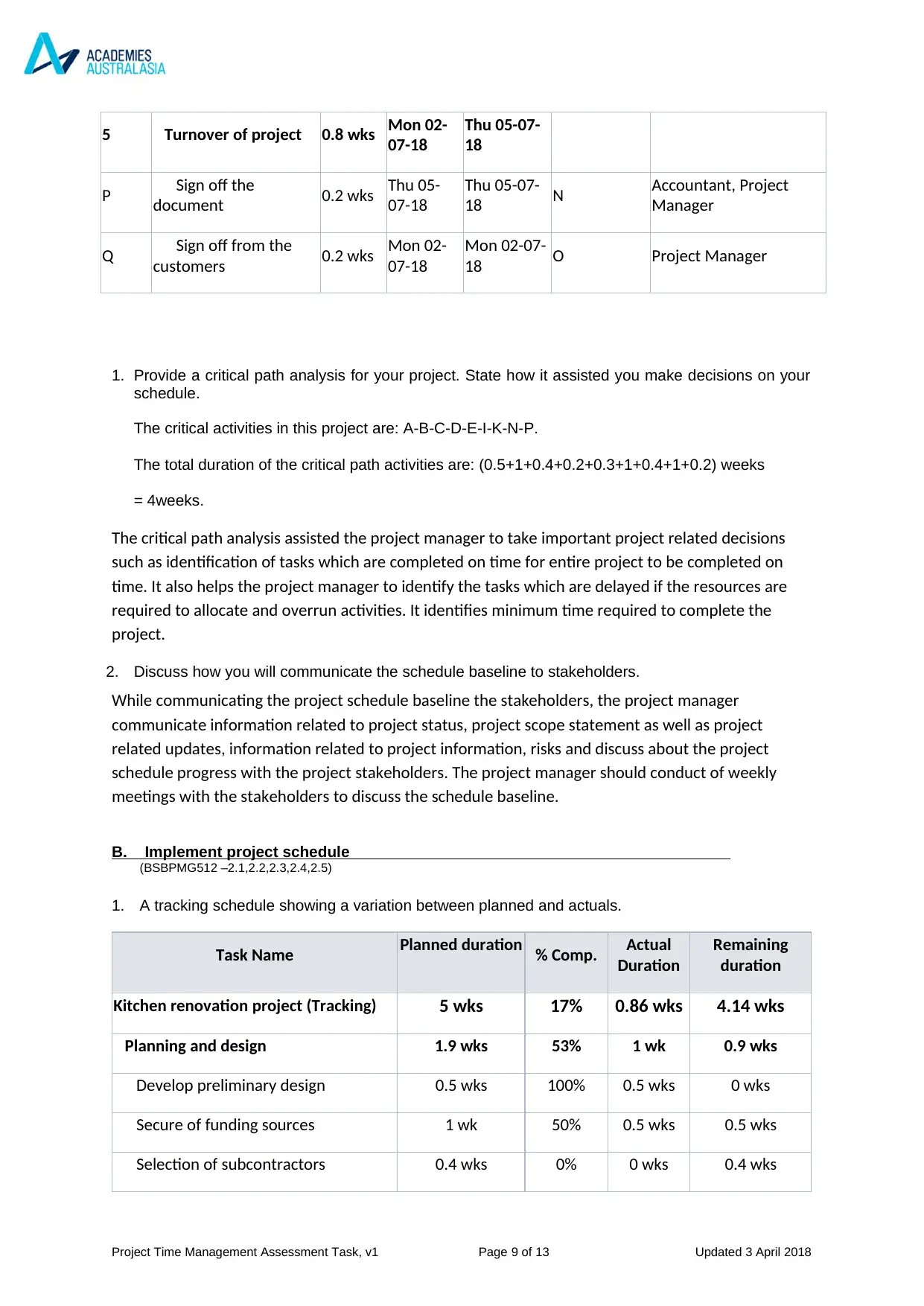
5 Turnover of project 0.8 wks Mon 02-
07-18
Thu 05-07-
18
P Sign off the
document 0.2 wks Thu 05-
07-18
Thu 05-07-
18 N Accountant, Project
Manager
Q Sign off from the
customers 0.2 wks Mon 02-
07-18
Mon 02-07-
18 O Project Manager
1. Provide a critical path analysis for your project. State how it assisted you make decisions on your
schedule.
The critical activities in this project are: A-B-C-D-E-I-K-N-P.
The total duration of the critical path activities are: (0.5+1+0.4+0.2+0.3+1+0.4+1+0.2) weeks
= 4weeks.
The critical path analysis assisted the project manager to take important project related decisions
such as identification of tasks which are completed on time for entire project to be completed on
time. It also helps the project manager to identify the tasks which are delayed if the resources are
required to allocate and overrun activities. It identifies minimum time required to complete the
project.
2. Discuss how you will communicate the schedule baseline to stakeholders.
While communicating the project schedule baseline the stakeholders, the project manager
communicate information related to project status, project scope statement as well as project
related updates, information related to project information, risks and discuss about the project
schedule progress with the project stakeholders. The project manager should conduct of weekly
meetings with the stakeholders to discuss the schedule baseline.
B. Implement project schedule
(BSBPMG512 –2.1,2.2,2.3,2.4,2.5)
1. A tracking schedule showing a variation between planned and actuals.
Task Name Planned duration % Comp. Actual
Duration
Remaining
duration
Kitchen renovation project (Tracking) 5 wks 17% 0.86 wks 4.14 wks
Planning and design 1.9 wks 53% 1 wk 0.9 wks
Develop preliminary design 0.5 wks 100% 0.5 wks 0 wks
Secure of funding sources 1 wk 50% 0.5 wks 0.5 wks
Selection of subcontractors 0.4 wks 0% 0 wks 0.4 wks
Project Time Management Assessment Task, v1 Page 9 of 13 Updated 3 April 2018
07-18
Thu 05-07-
18
P Sign off the
document 0.2 wks Thu 05-
07-18
Thu 05-07-
18 N Accountant, Project
Manager
Q Sign off from the
customers 0.2 wks Mon 02-
07-18
Mon 02-07-
18 O Project Manager
1. Provide a critical path analysis for your project. State how it assisted you make decisions on your
schedule.
The critical activities in this project are: A-B-C-D-E-I-K-N-P.
The total duration of the critical path activities are: (0.5+1+0.4+0.2+0.3+1+0.4+1+0.2) weeks
= 4weeks.
The critical path analysis assisted the project manager to take important project related decisions
such as identification of tasks which are completed on time for entire project to be completed on
time. It also helps the project manager to identify the tasks which are delayed if the resources are
required to allocate and overrun activities. It identifies minimum time required to complete the
project.
2. Discuss how you will communicate the schedule baseline to stakeholders.
While communicating the project schedule baseline the stakeholders, the project manager
communicate information related to project status, project scope statement as well as project
related updates, information related to project information, risks and discuss about the project
schedule progress with the project stakeholders. The project manager should conduct of weekly
meetings with the stakeholders to discuss the schedule baseline.
B. Implement project schedule
(BSBPMG512 –2.1,2.2,2.3,2.4,2.5)
1. A tracking schedule showing a variation between planned and actuals.
Task Name Planned duration % Comp. Actual
Duration
Remaining
duration
Kitchen renovation project (Tracking) 5 wks 17% 0.86 wks 4.14 wks
Planning and design 1.9 wks 53% 1 wk 0.9 wks
Develop preliminary design 0.5 wks 100% 0.5 wks 0 wks
Secure of funding sources 1 wk 50% 0.5 wks 0.5 wks
Selection of subcontractors 0.4 wks 0% 0 wks 0.4 wks
Project Time Management Assessment Task, v1 Page 9 of 13 Updated 3 April 2018
⊘ This is a preview!⊘
Do you want full access?
Subscribe today to unlock all pages.

Trusted by 1+ million students worldwide
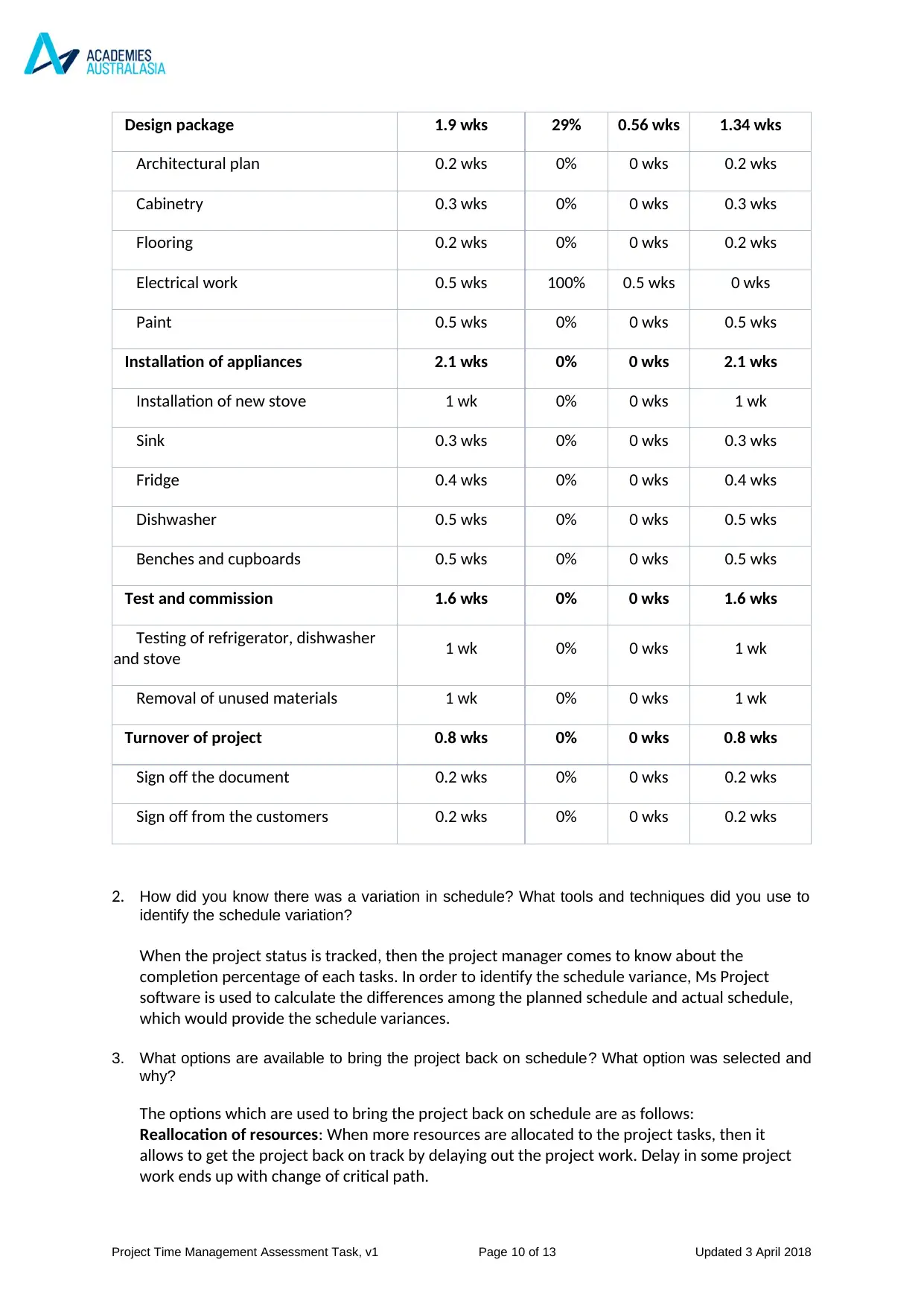
Design package 1.9 wks 29% 0.56 wks 1.34 wks
Architectural plan 0.2 wks 0% 0 wks 0.2 wks
Cabinetry 0.3 wks 0% 0 wks 0.3 wks
Flooring 0.2 wks 0% 0 wks 0.2 wks
Electrical work 0.5 wks 100% 0.5 wks 0 wks
Paint 0.5 wks 0% 0 wks 0.5 wks
Installation of appliances 2.1 wks 0% 0 wks 2.1 wks
Installation of new stove 1 wk 0% 0 wks 1 wk
Sink 0.3 wks 0% 0 wks 0.3 wks
Fridge 0.4 wks 0% 0 wks 0.4 wks
Dishwasher 0.5 wks 0% 0 wks 0.5 wks
Benches and cupboards 0.5 wks 0% 0 wks 0.5 wks
Test and commission 1.6 wks 0% 0 wks 1.6 wks
Testing of refrigerator, dishwasher
and stove 1 wk 0% 0 wks 1 wk
Removal of unused materials 1 wk 0% 0 wks 1 wk
Turnover of project 0.8 wks 0% 0 wks 0.8 wks
Sign off the document 0.2 wks 0% 0 wks 0.2 wks
Sign off from the customers 0.2 wks 0% 0 wks 0.2 wks
2. How did you know there was a variation in schedule? What tools and techniques did you use to
identify the schedule variation?
When the project status is tracked, then the project manager comes to know about the
completion percentage of each tasks. In order to identify the schedule variance, Ms Project
software is used to calculate the differences among the planned schedule and actual schedule,
which would provide the schedule variances.
3. What options are available to bring the project back on schedule? What option was selected and
why?
The options which are used to bring the project back on schedule are as follows:
Reallocation of resources: When more resources are allocated to the project tasks, then it
allows to get the project back on track by delaying out the project work. Delay in some project
work ends up with change of critical path.
Project Time Management Assessment Task, v1 Page 10 of 13 Updated 3 April 2018
Architectural plan 0.2 wks 0% 0 wks 0.2 wks
Cabinetry 0.3 wks 0% 0 wks 0.3 wks
Flooring 0.2 wks 0% 0 wks 0.2 wks
Electrical work 0.5 wks 100% 0.5 wks 0 wks
Paint 0.5 wks 0% 0 wks 0.5 wks
Installation of appliances 2.1 wks 0% 0 wks 2.1 wks
Installation of new stove 1 wk 0% 0 wks 1 wk
Sink 0.3 wks 0% 0 wks 0.3 wks
Fridge 0.4 wks 0% 0 wks 0.4 wks
Dishwasher 0.5 wks 0% 0 wks 0.5 wks
Benches and cupboards 0.5 wks 0% 0 wks 0.5 wks
Test and commission 1.6 wks 0% 0 wks 1.6 wks
Testing of refrigerator, dishwasher
and stove 1 wk 0% 0 wks 1 wk
Removal of unused materials 1 wk 0% 0 wks 1 wk
Turnover of project 0.8 wks 0% 0 wks 0.8 wks
Sign off the document 0.2 wks 0% 0 wks 0.2 wks
Sign off from the customers 0.2 wks 0% 0 wks 0.2 wks
2. How did you know there was a variation in schedule? What tools and techniques did you use to
identify the schedule variation?
When the project status is tracked, then the project manager comes to know about the
completion percentage of each tasks. In order to identify the schedule variance, Ms Project
software is used to calculate the differences among the planned schedule and actual schedule,
which would provide the schedule variances.
3. What options are available to bring the project back on schedule? What option was selected and
why?
The options which are used to bring the project back on schedule are as follows:
Reallocation of resources: When more resources are allocated to the project tasks, then it
allows to get the project back on track by delaying out the project work. Delay in some project
work ends up with change of critical path.
Project Time Management Assessment Task, v1 Page 10 of 13 Updated 3 April 2018
Paraphrase This Document
Need a fresh take? Get an instant paraphrase of this document with our AI Paraphraser
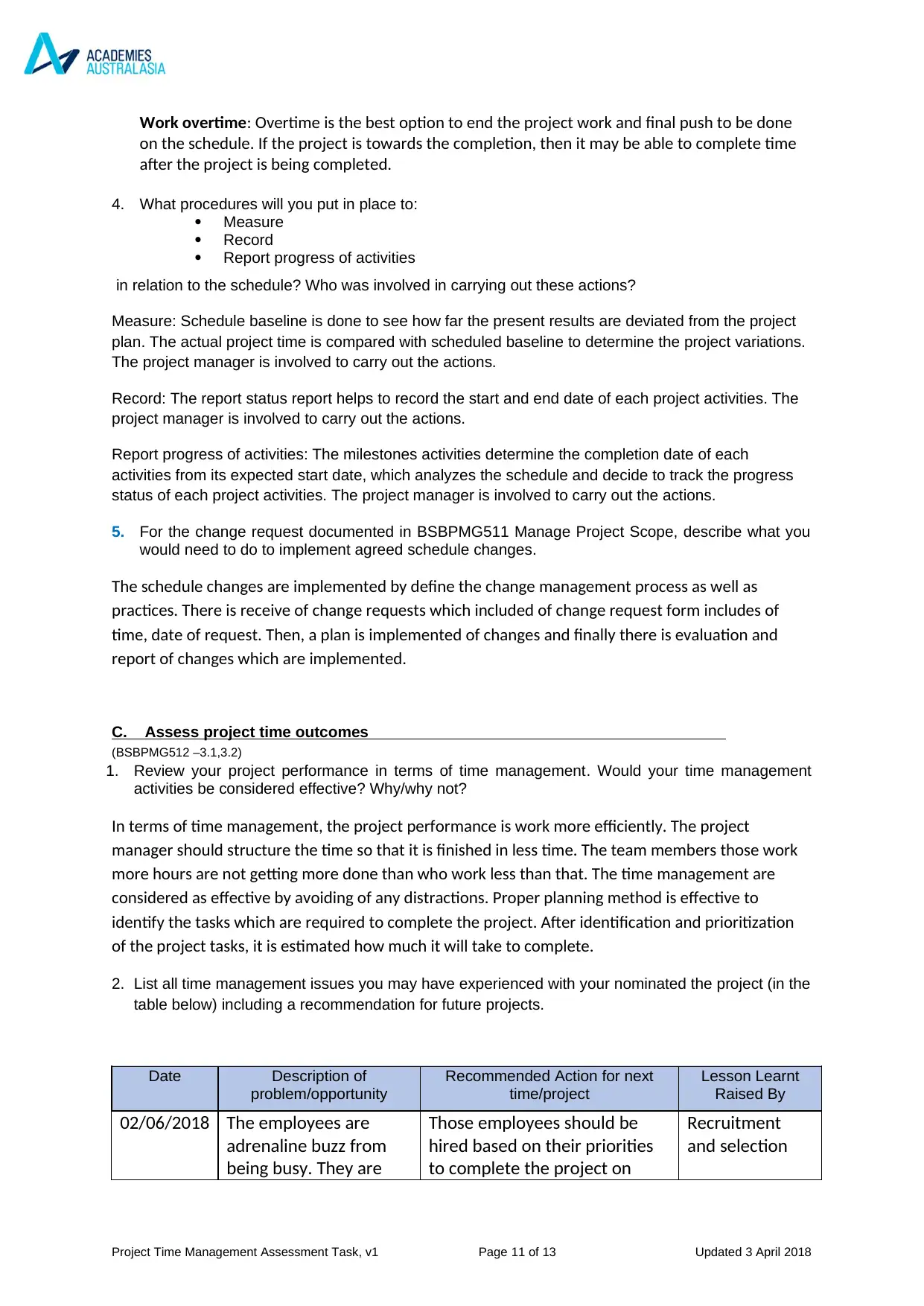
Work overtime: Overtime is the best option to end the project work and final push to be done
on the schedule. If the project is towards the completion, then it may be able to complete time
after the project is being completed.
4. What procedures will you put in place to:
Measure
Record
Report progress of activities
in relation to the schedule? Who was involved in carrying out these actions?
Measure: Schedule baseline is done to see how far the present results are deviated from the project
plan. The actual project time is compared with scheduled baseline to determine the project variations.
The project manager is involved to carry out the actions.
Record: The report status report helps to record the start and end date of each project activities. The
project manager is involved to carry out the actions.
Report progress of activities: The milestones activities determine the completion date of each
activities from its expected start date, which analyzes the schedule and decide to track the progress
status of each project activities. The project manager is involved to carry out the actions.
5. For the change request documented in BSBPMG511 Manage Project Scope, describe what you
would need to do to implement agreed schedule changes.
The schedule changes are implemented by define the change management process as well as
practices. There is receive of change requests which included of change request form includes of
time, date of request. Then, a plan is implemented of changes and finally there is evaluation and
report of changes which are implemented.
C. Assess project time outcomes
(BSBPMG512 –3.1,3.2)
1. Review your project performance in terms of time management. Would your time management
activities be considered effective? Why/why not?
In terms of time management, the project performance is work more efficiently. The project
manager should structure the time so that it is finished in less time. The team members those work
more hours are not getting more done than who work less than that. The time management are
considered as effective by avoiding of any distractions. Proper planning method is effective to
identify the tasks which are required to complete the project. After identification and prioritization
of the project tasks, it is estimated how much it will take to complete.
2. List all time management issues you may have experienced with your nominated the project (in the
table below) including a recommendation for future projects.
Date Description of
problem/opportunity
Recommended Action for next
time/project
Lesson Learnt
Raised By
02/06/2018 The employees are
adrenaline buzz from
being busy. They are
Those employees should be
hired based on their priorities
to complete the project on
Recruitment
and selection
Project Time Management Assessment Task, v1 Page 11 of 13 Updated 3 April 2018
on the schedule. If the project is towards the completion, then it may be able to complete time
after the project is being completed.
4. What procedures will you put in place to:
Measure
Record
Report progress of activities
in relation to the schedule? Who was involved in carrying out these actions?
Measure: Schedule baseline is done to see how far the present results are deviated from the project
plan. The actual project time is compared with scheduled baseline to determine the project variations.
The project manager is involved to carry out the actions.
Record: The report status report helps to record the start and end date of each project activities. The
project manager is involved to carry out the actions.
Report progress of activities: The milestones activities determine the completion date of each
activities from its expected start date, which analyzes the schedule and decide to track the progress
status of each project activities. The project manager is involved to carry out the actions.
5. For the change request documented in BSBPMG511 Manage Project Scope, describe what you
would need to do to implement agreed schedule changes.
The schedule changes are implemented by define the change management process as well as
practices. There is receive of change requests which included of change request form includes of
time, date of request. Then, a plan is implemented of changes and finally there is evaluation and
report of changes which are implemented.
C. Assess project time outcomes
(BSBPMG512 –3.1,3.2)
1. Review your project performance in terms of time management. Would your time management
activities be considered effective? Why/why not?
In terms of time management, the project performance is work more efficiently. The project
manager should structure the time so that it is finished in less time. The team members those work
more hours are not getting more done than who work less than that. The time management are
considered as effective by avoiding of any distractions. Proper planning method is effective to
identify the tasks which are required to complete the project. After identification and prioritization
of the project tasks, it is estimated how much it will take to complete.
2. List all time management issues you may have experienced with your nominated the project (in the
table below) including a recommendation for future projects.
Date Description of
problem/opportunity
Recommended Action for next
time/project
Lesson Learnt
Raised By
02/06/2018 The employees are
adrenaline buzz from
being busy. They are
Those employees should be
hired based on their priorities
to complete the project on
Recruitment
and selection
Project Time Management Assessment Task, v1 Page 11 of 13 Updated 3 April 2018
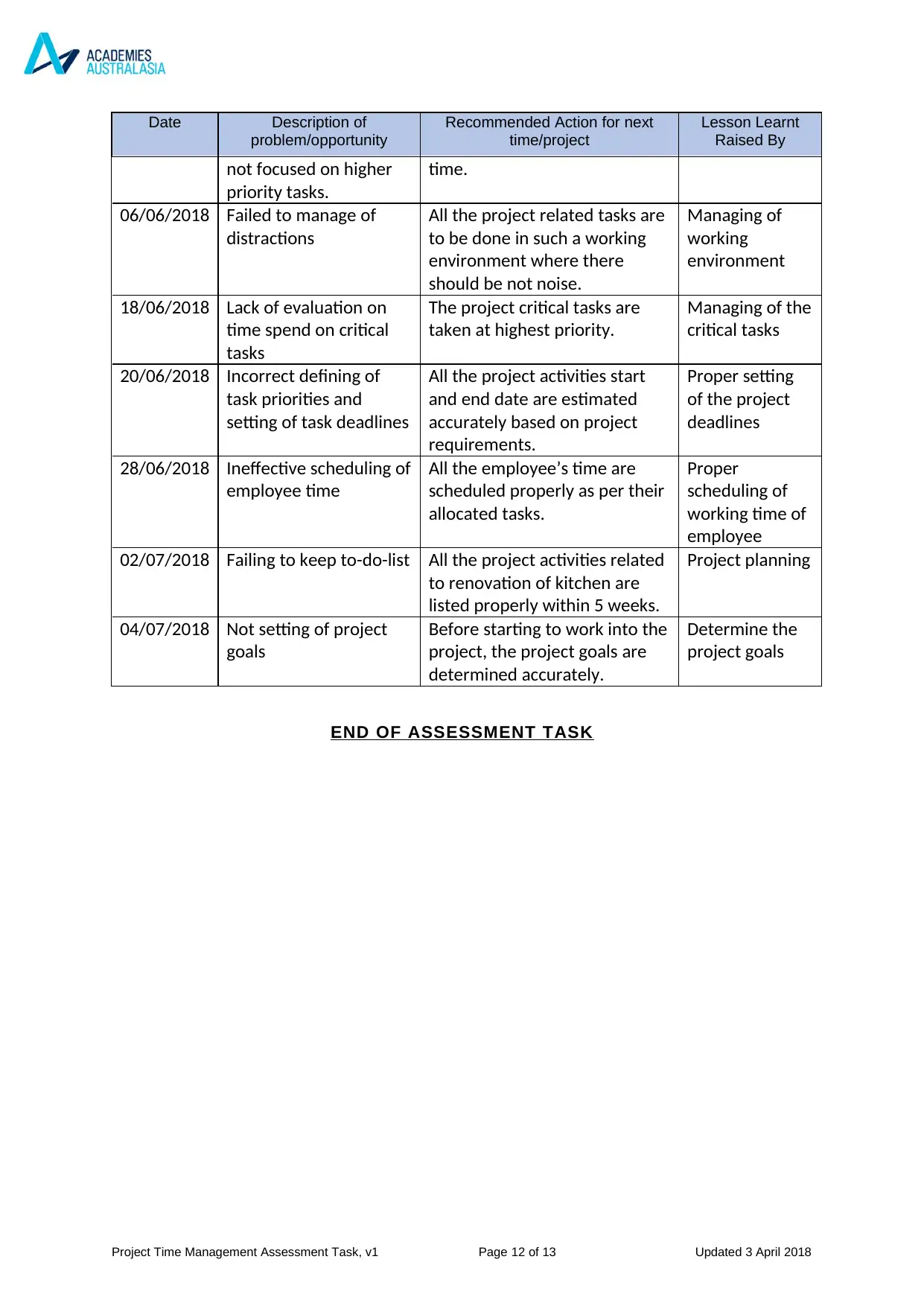
Date Description of
problem/opportunity
Recommended Action for next
time/project
Lesson Learnt
Raised By
not focused on higher
priority tasks.
time.
06/06/2018 Failed to manage of
distractions
All the project related tasks are
to be done in such a working
environment where there
should be not noise.
Managing of
working
environment
18/06/2018 Lack of evaluation on
time spend on critical
tasks
The project critical tasks are
taken at highest priority.
Managing of the
critical tasks
20/06/2018 Incorrect defining of
task priorities and
setting of task deadlines
All the project activities start
and end date are estimated
accurately based on project
requirements.
Proper setting
of the project
deadlines
28/06/2018 Ineffective scheduling of
employee time
All the employee’s time are
scheduled properly as per their
allocated tasks.
Proper
scheduling of
working time of
employee
02/07/2018 Failing to keep to-do-list All the project activities related
to renovation of kitchen are
listed properly within 5 weeks.
Project planning
04/07/2018 Not setting of project
goals
Before starting to work into the
project, the project goals are
determined accurately.
Determine the
project goals
END OF ASSESSMENT TASK
Project Time Management Assessment Task, v1 Page 12 of 13 Updated 3 April 2018
problem/opportunity
Recommended Action for next
time/project
Lesson Learnt
Raised By
not focused on higher
priority tasks.
time.
06/06/2018 Failed to manage of
distractions
All the project related tasks are
to be done in such a working
environment where there
should be not noise.
Managing of
working
environment
18/06/2018 Lack of evaluation on
time spend on critical
tasks
The project critical tasks are
taken at highest priority.
Managing of the
critical tasks
20/06/2018 Incorrect defining of
task priorities and
setting of task deadlines
All the project activities start
and end date are estimated
accurately based on project
requirements.
Proper setting
of the project
deadlines
28/06/2018 Ineffective scheduling of
employee time
All the employee’s time are
scheduled properly as per their
allocated tasks.
Proper
scheduling of
working time of
employee
02/07/2018 Failing to keep to-do-list All the project activities related
to renovation of kitchen are
listed properly within 5 weeks.
Project planning
04/07/2018 Not setting of project
goals
Before starting to work into the
project, the project goals are
determined accurately.
Determine the
project goals
END OF ASSESSMENT TASK
Project Time Management Assessment Task, v1 Page 12 of 13 Updated 3 April 2018
⊘ This is a preview!⊘
Do you want full access?
Subscribe today to unlock all pages.

Trusted by 1+ million students worldwide
1 out of 13
Related Documents
Your All-in-One AI-Powered Toolkit for Academic Success.
+13062052269
info@desklib.com
Available 24*7 on WhatsApp / Email
![[object Object]](/_next/static/media/star-bottom.7253800d.svg)
Unlock your academic potential
Copyright © 2020–2025 A2Z Services. All Rights Reserved. Developed and managed by ZUCOL.





